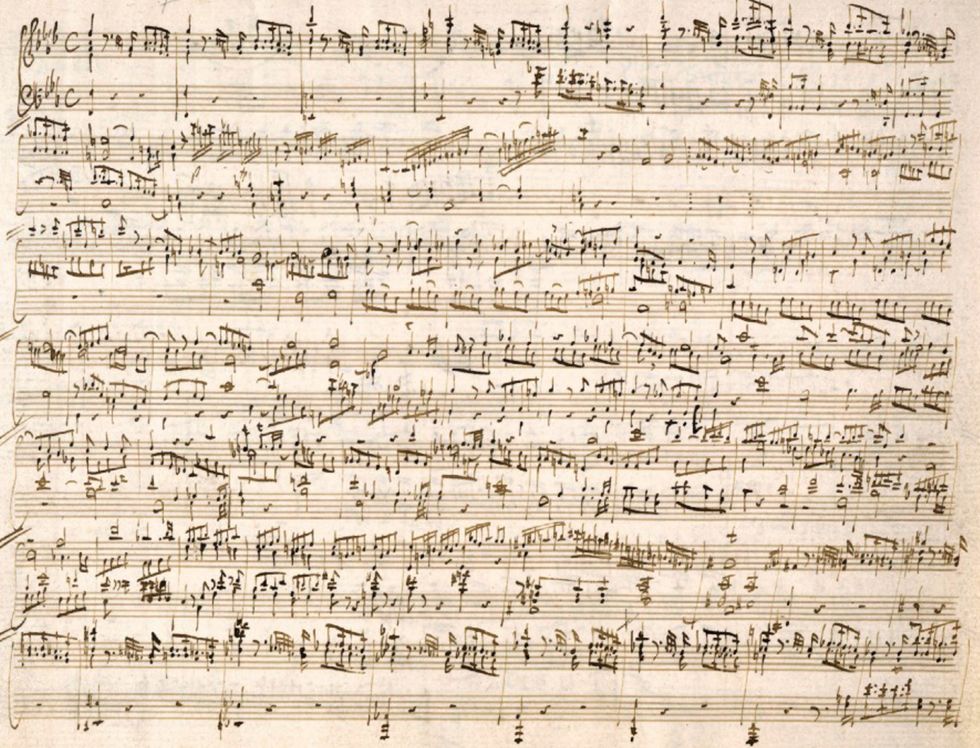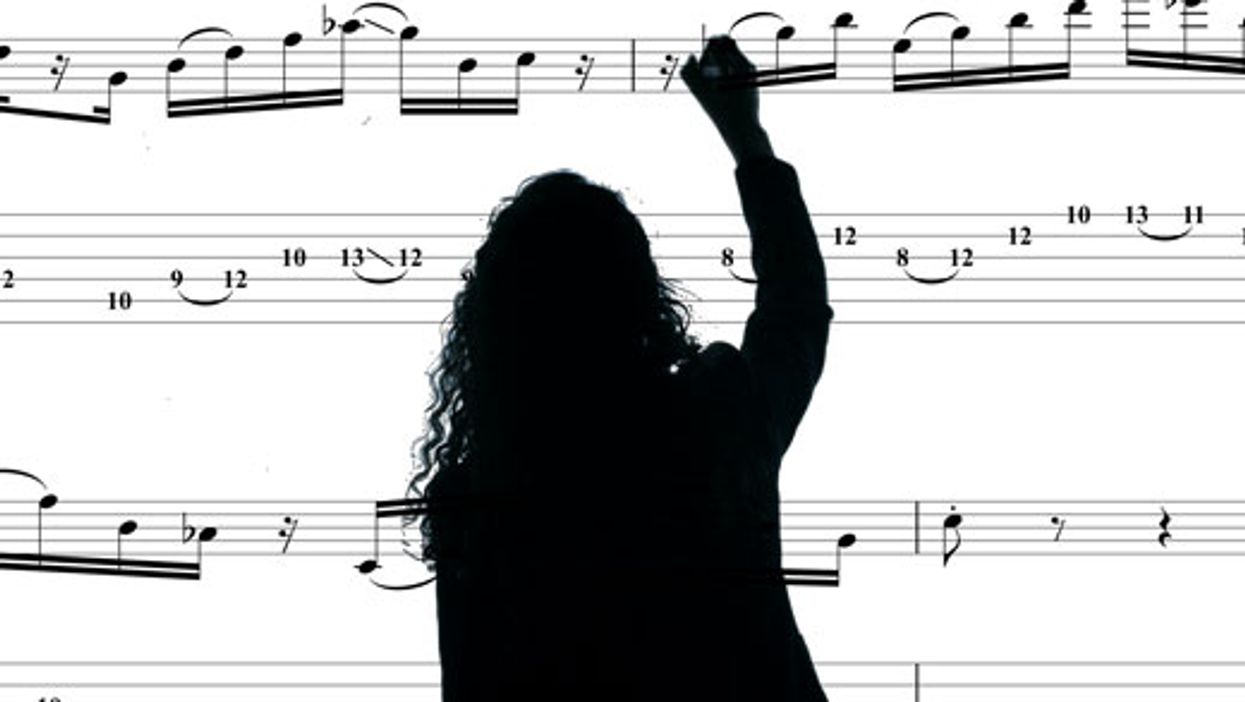Chops: Intermediate Theory: Intermediate Lesson Overview: • Learn how to take a simple phrase and mutate it all around the fretboard. • Understand how to systematically move through a pentatonic scale. • Improve your knowledge of shapes across string sets. Click here to download a printable PDF of this lesson's notation. |
Do you feel like that ancient, half-eaten box of cereal in your kitchen has more snap, crackle, and pop than your last solo? Do you see guitarists blaze across the fretboard and ask yourself “Why not me?” Do you think you’re playing all the right notes, but in reality, it sounds slightly stilted and hastily drawn? Maybe you’re just bored?
You have to remember that music is a performance practice. If you don’t practice it, you don’t perform it very well. No matter your past experience or current skill level, you need musical challenges to progress. Whether you’re learning a new style, or copping another player’s vibe, it takes new input to make your playing fresh, authentic, and interesting. There is a remedy, my friend. You need to transcribe.
After memorizing a solo, find the lines that speak to you musically, and then go to the process of internalizing and understanding them. You want to be able to play those lines whenever you want. I will explain a few methods that will help you do just that.
Take a look at Ex. 1. Suppose, for a moment, that this is a line from your transcription and you want to internalize it. You say to yourself, “Man… this sounds a lot like Clapton, and I love Eric Clapton.” The first thing to do is to completely dissect the line. Figure out what scale is being used; what is the sequence of scale tones being played; what strings, string pattern, and rhythms are used? Are there any bends, and if so, what kind?
That project will give you the following information:
- This line uses the D minor pentatonic scale (D–F–G–A–C).
- It starts on the “and” of beat 1 and uses mostly triplets.
- There are only two bends: b7 to root and a quarter-tone bend on the b3.
- It’s played on strings 2-4.
Yes, that’s a lot detail to remember. But if you want to regenerate this line in different positions of the neck, you need to completely understand what’s being played.
Click here for Ex. 1
The first method is the “All Five” approach. Play this line in all five of the minor pentatonic patterns. Ex. 2 is in fifth position on the guitar, beginning with the whole step bend on the 1st string.
Click here for Ex. 2
In Fig. 3 I move the line down an octave and into 2nd position with the first bend on the 3rd string.
Click here for Ex. 3
We stay in the same octave for Ex. 4 but place it in 7th position.
Click here for Ex. 4
Next up is the “Y-Axis” method of replicating a line. You’re going to stay in the same position but move the line to each string set. Remember, don’t just move the same finger pattern up and down. You have to use the notes in the D minor pentatonic scale, otherwise you’re going to get some really interesting results. And by “interesting,” I mean “wrong.” Ex. 5 is a good example of how you have to keep your eyeballs on the notes of the D minor pentatonic scale in 10th position.
Click here for Ex. 5
Ex. 6 is a little bit more straightforward, but Ex. 7 will make you think a little bit, especially with that bend to the 9 at the beginning of the line.
Click here for Ex. 6
Click here for Ex. 7
As with any proper two-dimensional universe, the next set of lines are generated from the “X-axis” method. Keep the line on the same set of stings but move it lengthwise along the neck through all five minor pentatonic patterns. Like the previous method, keep your eyes on each pattern of the pentatonic scale system. With this particular line, the whole step bend at the beginning the line will yield a couple of modal flavors. Ex. 8 is played in 12th position and begins with a bend to the 9, evoking an “All Along the Watchtower” situation.
Click here for Ex. 8
Ex. 9 starts in 8th position and begins with a bend to the 13 (or 6) and sticks the landing on the root. It’s a little weird under the fingers, but challenges are good, right?
Click here for Ex. 9
Ex. 10 is in 5th position and is solid meat-and-potatoes pentatonic fare.
Click here for Ex. 10
Ex. 11 is a little more challenging due to the minor third intervals on the 2nd and 3rd strings, but is still doable and has a subtle Robben Ford flair to it.
Click here for Ex. 11
These methods work for all styles because they are designed to make you really think about what scale tones, rhythms, and fingerings are being used. When you move the original line to another position or a different set of strings, you see new possibilities emerge and find new pathways across the neck.
If you’re determined to get inside the head of another player, there’s one more method you can use, especially if your transcription has more harmonic content or multiple key centers. If you’ve worked on a solo long enough, it’s easy to forget about the chord changes you’re playing over. But, to really understand someone else’s style, you have to understand what they play over a specific chord. What do they typically play over major and minor chords? How about the different types of seventh chords?
Take each line and group them by chord type, and then transpose them to the same key. The last two examples are from a transcription I did recently. The original lines were played over either G7, A7, or C7. I transposed them all to work over C7 and then organized them by position.
The first two measures in Ex. 12 are similar, starting on the 3 and arpeggiating up to the 9 before making a leap to the 13. The third measure starts with chord tones of C7 before again jumping from the 9 to the 13. The fourth measure is what would later become standard bebop vocabulary—moving chromatically from the root down to the b7. If I only had these four measures to capture this person’s style, I would lean on:
- Arpeggiating from the 3rd
- Leaping from the 9th to the 13th
- Moving chromatically down from the root
Click here for Ex. 12
There’s a little more to work with in Ex. 13, but there are still some similarities. Check out the second half of measure 1 and compare it to measure 4. Compare measure 3 and 6. There’s some tasty chromatic action near the 3 of the chord followed by an identical arpeggio. And on a personal note, I’ve been working out the second half of measure 5, sequencing it up and down the neck in the Mixolydian mode.
Click here for Ex. 13
Whatever you find in your own transcribing, use these methods to internalize someone else’s vocabulary and make it your own. It will be challenging and thought provoking, and it will add some new flavors to your playing.

















